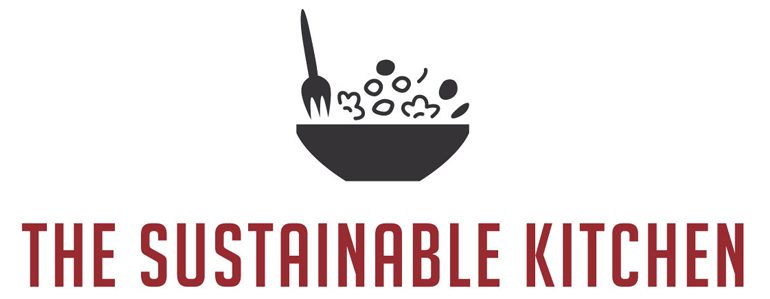HISTORY OF SPRING ROLLS
Like with most foods, the exact origins are unknown. Spring rolls are believed to have originated in China during the Jin Dynasty, which lasted from 265 AD to 420 AD. It looked more like a pancake than the spring rolls we know of today, which are cylindrical. This was usually made to commemorate the first day of Spring and the name was given as the rolls were filled with seasonal spring vegetables.
The dish eventually spread to other parts of Asia, including Vietnam, where it became a popular street food. The Vietnamese spring rolls have many different names depending on the region you are in. In South Vietnam, they are called Goi cuon. In North Vietnam, they are referred to as nem cuon. In English, it is usually referred to as spring rolls, summer rolls, cold rolls, and salad rolls.
Vietnam also has two varieties: cha gio and goi cuon. Cha Gio is made with protein such as pork and shrimp, cellophone noodles, aromatic, and fried. Goi cuon are fresher, lighter, and not fried making it more healthier than cha gio. The spring rolls we know of today are believed to have come from Southern Vietnam. Because of the abundance of fresh produce, the Vietnamese people modified the Chinese spring roll to fit their Vietnamese palate and used the regional produce available to them.

ANATOMY OF A SPRING ROLL
Making spring rolls is easy and only requires a few ingredients. It’s also customizable if you are a vegetarian as tofu can be replaced with meat proteins. All you need is rice paper and your fillings of choice. The sauce is simple to make as well and only requires a few ingredients.
Rice Paper
Rice paper, or banh trang in Vietnamese, is an edible wrapper made of rice (sometimes tapioca) flour. It’s sold dehydrated and is hydrated at home by dipping them in water for a few seconds. They come in a variety of shapes and sizes.
Using high-quality rice paper is essential to a good Vietnamese spring roll. The rice paper will vary from region to region as different techniques are used. Some rice papers are thinner, while others are thicker and chewier. My favorite brand to use is the Three Ladies brand as they do not tear when you are rolling them.
Fill a large bowl with warm tap water to prepare the rice paper. Dip a sheet of rice paper in the water so it’s completely submerged and remove it immediately. Lay it on a plate and let it sit for 5 seconds as it will rehydrate and become more pliable. After that, you can add the filling of your choice and roll it into a spring roll.
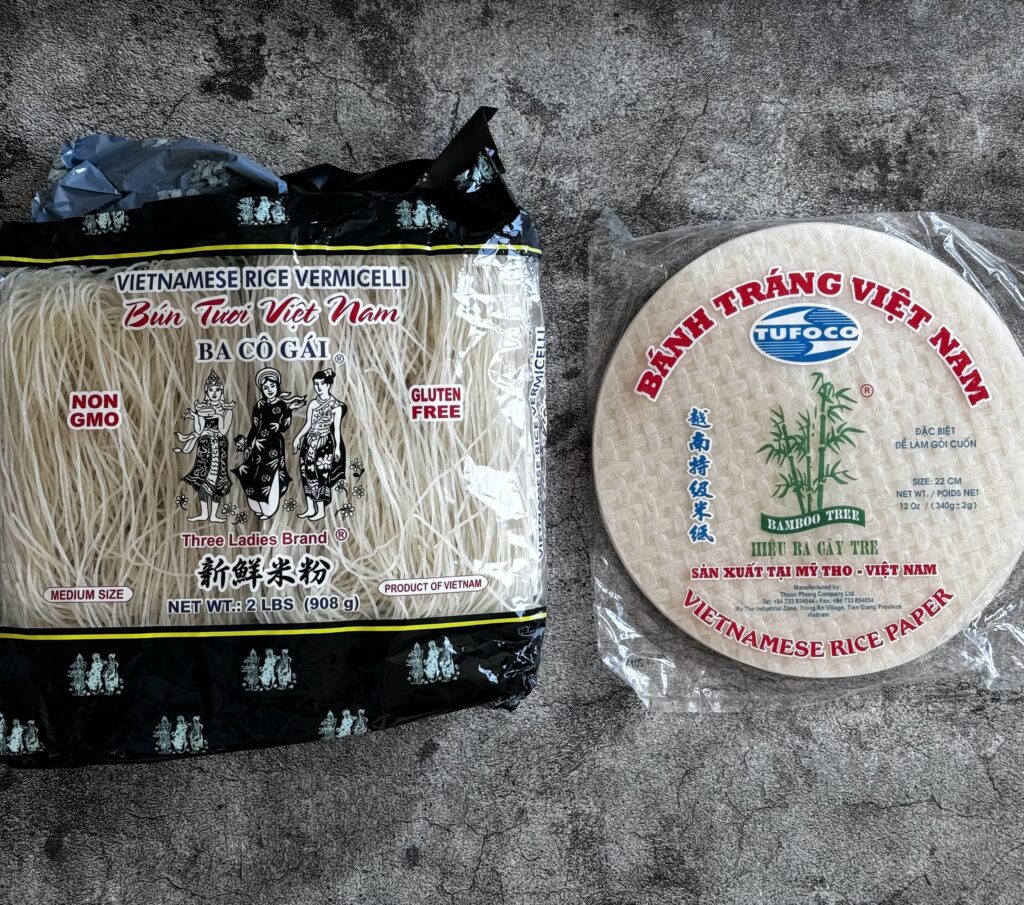
Some tips for soaking rice papers:
- don’t oversoak your rice paper as it will become soggy and too fragile to roll. You want to immediately remove your rice paper as soon as all surface is wet
- use warm to hot tap water. Do not use boiling water as the rice paper will become too soft
- rice paper with tapioca in it will be more chewier and easier to wrap. Rice paper made with 100% rice will be a bit more difficult to work with
- use a shallow bowl that is deep enough to submerge the rice paper. You can also get a rice paper water dipping bowl as they are upright and you can rotate the rice paper in the water.
Rice Vermicelli
Cook your rice vermicelli according to the package instructions. Make sure to drain and rinse them under cold water until it is cooled. Drain them for 10-15 minutes so they can dry out before using them in spring rolls. My favorite brand is the The Three Ladies brand as well.
Protein
There are many types of protein to choose from. You can even marinate meats, and mushrooms, and pan-fry or boil the proteins. For the recipe, I will keep it simple and use shrimp only as my protein. You will need about 15 jumbo shrimp peeled and deveined. Fill a small saucepan with water, and add 1/2 tsp salt and a 1-inch piece of ginger, lightly smashed.
Bring the pan to a boil over medium heat, add the shrimp, and boil for 1-2 minutes. Cover the lid, and remove the pot from the heat. Let it stand for 3 minutes until the shrimp is curly and pinkish orange. Transfer the shrimp to a bowl of ice water. Drain and halve the shrimp lengthwise.

If you are short on time, you can also buy store-bought shrimp sold in shrimp cocktails. This is usually in the deli section of your grocery store. You will only have to halve the shrimp for this. If you are making this for a large crowd, Costco sells shrimp cocktail trays which will be perfect for this recipe.
If you are a vegetarian, you can substitute any meat with tofu, mushrooms, tempeh, or even omelet strips.
Vegetables
Think leafy greens like green leaf lettuce, red leaf lettuce, or butter lettuce. Other fresh vegetables are cucumbers, carrots, peppers, radish, or daikon. I also like to use fresh jalapeno slices for an extra kick. You will want to slice the crunchy vegetables, like cucumbers and carrots into matchsticks.
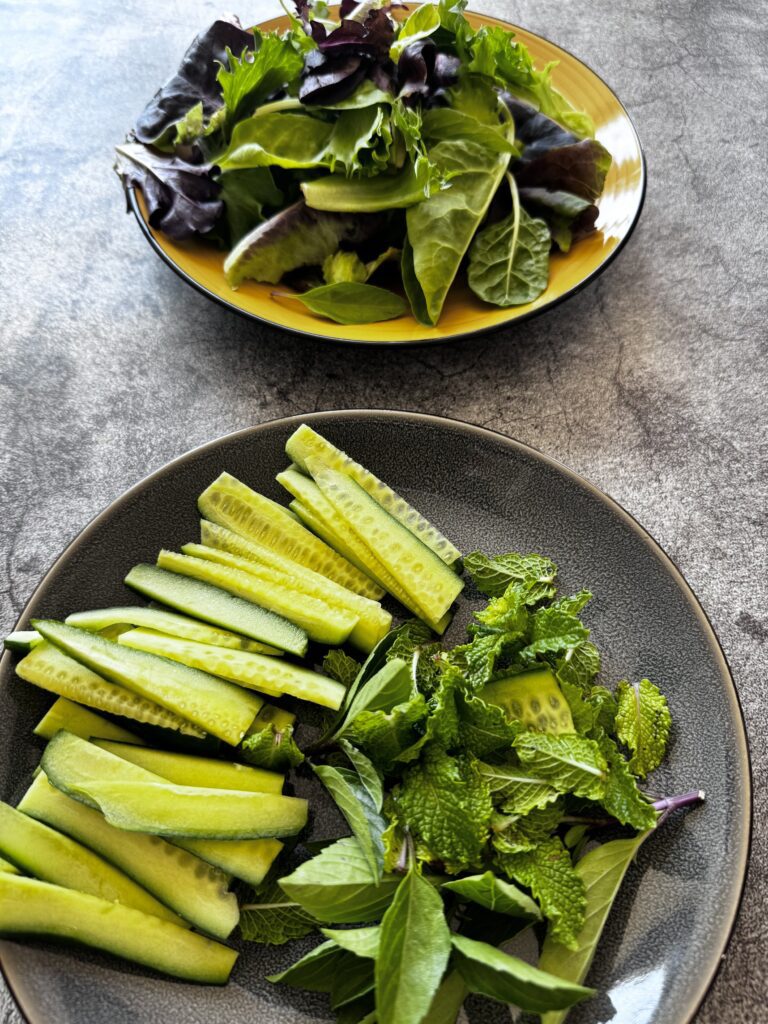
Herbs
My favorite part of the spring rolls are fresh herbs. I like adding cilantro, garlic chives, mint leaves, and Thai basil to my rolls. At a bare minimum, you should have cilantro and mint.
Dipping Sauce
Considered to be the most important part of spring rolls, the dipping sauce can be made in two ways: Peanut sauce or fish sauce vinaigrette. Each region has its preferred version. In the north, nuoc mam, which is a combination of fish sauce, lime juice, garlic, chili, water, and sugar is used. In central and south Vietnam, peanut sauce is used. Traditional peanut sauce is made with a soy sauce made with fermented beans and sweet rice porridge. Minced pork or pork liver is added to create a fatty creamy texture.
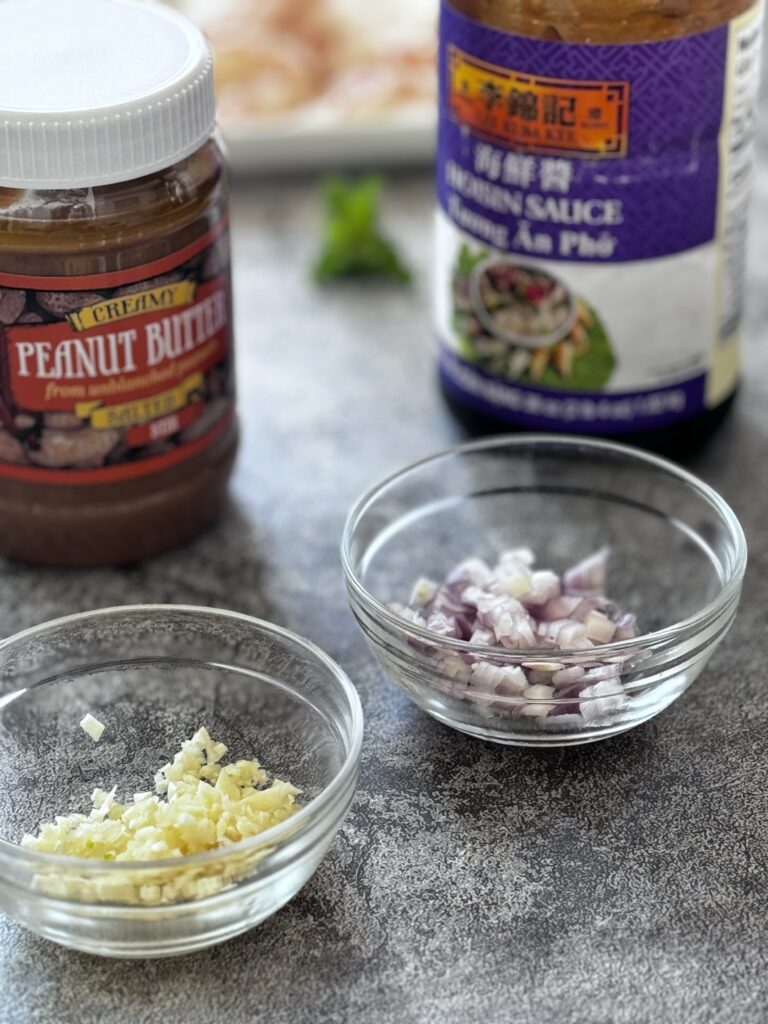
Peanut butter was added for a more modern version when Vietnamese people migrated out of the country. The peanut butter made a nice substitution for the fermented beans and the creamy fatty pork. My favorite sauce is the peanut sauce. Everyone has their version, so feel free to experiment and use my recipe as a base. You will need creamy peanut butter, hoisin sauce, garlic, shallots, sugar, and oil. Adding vinegar will extend the life of the sauce.
STEPS TO ROLLING A SPRING ROLL
Make sure you have all your ingredients out on a large platter. Ensure that your bowl of warm water and close by. Also, you will need a flat, dry surface, like a large dinner plate or cutting board larger than your rice paper. Preparation is key here!
Step 1: Set up your workspace
Mise en place is very important here, so make sure you have all ingredients out and at hand. Place your cutting board nearest to you and slightly dampen it. Have your vegetables, herbs, rice noodles, and shrimp on plates nearby.
Step 2: Dip the rice paper in warm water
Quickly dip the rice paper in your bowl of warm water, no longer than a few seconds, ensuring the entire surface is wet. You can also use a rice paper dipper like this one. Take out immediately and lay it flat on your board. The paper will continue to hydrate and soften as it sits on the board, so do not wait too long to add your ingredient.
Step 3: Add the filling
Place a piece of lettuce over the edge closest to you on the rice paper. Add about 2-3 tablespoons of rice noodles on top of that, followed by your vegetables, and then herbs. Arrange 3 pieces of shrimp, orange/pink side facing down, about 1.5 to 2 inches below the top edge of the rice paper.
Step 4: Roll the Spring roll
From the bottom up, roll the lower edge of the rice paper, lift, and roll up the spring roll. When you get to the shrimp, fold the right and left sides in, then continue to roll up until the end.
CAN YOU MAKE SPRING ROLLS AHEAD?
Spring rolls are best made and eaten fresh, but you can prep some ingredients ahead. I highly recommend you eat these within 2-3 hours of making them as if left out, the rice paper will harden. While you can quickly microwave the spring rolls for about 20 seconds, the texture will be very chewy. It will also be unevenly hydrated, and the vegetables will be heated inside, which is not great.
You can cook the shrimp and prep your veggies and herbs a day ahead. You can also make the peanut sauce ahead of time, up to 2 days ahead. If needed, you can make these ahead one day, but make sure you individually wrap each roll tightly with plastic wrap to prevent them from drying out.
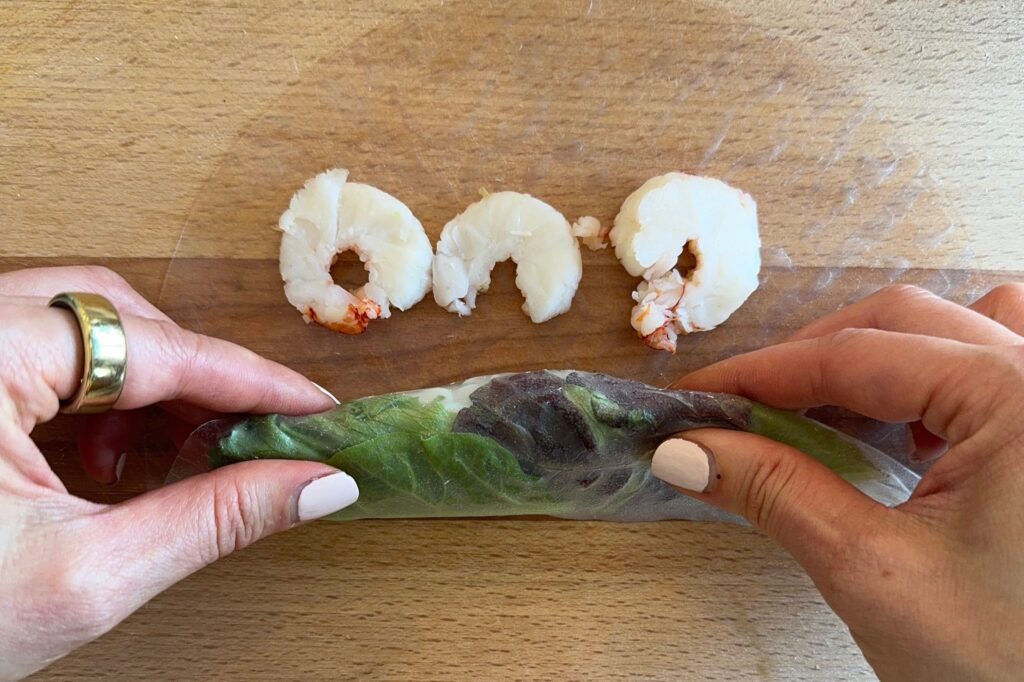
TIPS FOR MAKING SPRING ROLLS
Follow these tips for the best spring rolls.
- Mise en Place – Make sure you have your work surface ready to roll. Prep your veggies, herbs, and shrimp. Have all ingredients at hand so you can quickly roll the spring rolls, avoiding the rice paper drying out.
- Lettuce Prep – Any leafy green lettuce can be used. Remove any stiff stems to avoid the stems from piercing the rice paper wrapper
- The Peanut Sauce – The peanut sauce can be prepared 2 days in advance. Alternatively, you can also prepare the nuoc mam dipping sauce 2 days in advance too.
- Experiment with Ingredients – Shrimp spring rolls usually contain pork, but I omitted them. You can replace any shrimp with your protein of choice. Grilled meats or sausages can also be used. To make vegetarian, replace meats with tofu, tempeh, and mushrooms. Experiment with other vegetables such as julienned carrots or sweet bell peppers.
- Making for a Large Crowd – If you are making this for a large crowd, make it about 2 hours ahead of serving. Keep them refrigerated and place a damp paper towel over them until serving to prevent drying out.
- Use Shrimp Cocktail Shrimps – If you do not feel like peeling and deveining shrimp, get a shrimp cocktail platter in the deli section of your grocery store. You will only need to slice the shrimp lengthwise.
- Prevent Spring Rolls from Sticking Together – Do not place completed spring rolls next to each other or on top of each other as they will stick. You can wrap each spring roll individually with plastic wrap to prevent them from drying.
EQUIPMENT NEEDED
For this recipe, you will need the following.
- A deep bowl or spring roll dipper
- A large board
THE RECIPE
This shrimp spring roll recipe is easy to make and is customizable to your needs. The peanut dipping sauce recipe is quick and easy and is a must! Made with fresh shrimp, vegetables, herbs, and rice vermicelli, it is then rolled with rice paper and accompanied by a peanut dipping sauce.

WHAT YOU WILL NEED:
For the Spring Rolls
- 18 medium shell-on shrimp (21/25 count *See Notes
- 1/2 teaspoon salt
- 1/2 inch ginger
- 3 ounces rice vermicelli
- 1-2 Persian cucumbers, cut into matchsticks
- 12 pieces of butter lettuce
- 1/2 cup mint leaves
- 1/2 Thai basil
- 12 large 22cm circular rice paper sheets
- Warm water for rolling spring rolls
For the Peanut Sauce
- 1/2 tablespoon cooking oil
- 1 tablespoon minced garlic
- 2 tablespoon chopped shallots
- 3/4 cup water
- 1/2 cup hoisin sauce
- 3 tablespoon creamy peanut butter
- 1 tablespoon white vinegar
- 1/2 tablespoon sugar
Prepare the Shrimp
Step 1:
Defrost the shrimp, remove the shells, and devein the shrimp. Add shrimp, salt, ginger, and water to a small pot to barely cover the shrimp. Boil on medium-high heat for about 1-2 minutes. Take off the heat and cover for 3 minutes. Transfer the shrimp to a bowl of ice water.
Step 2:
Cut the shrimp in half along the body and set aside on a plate.
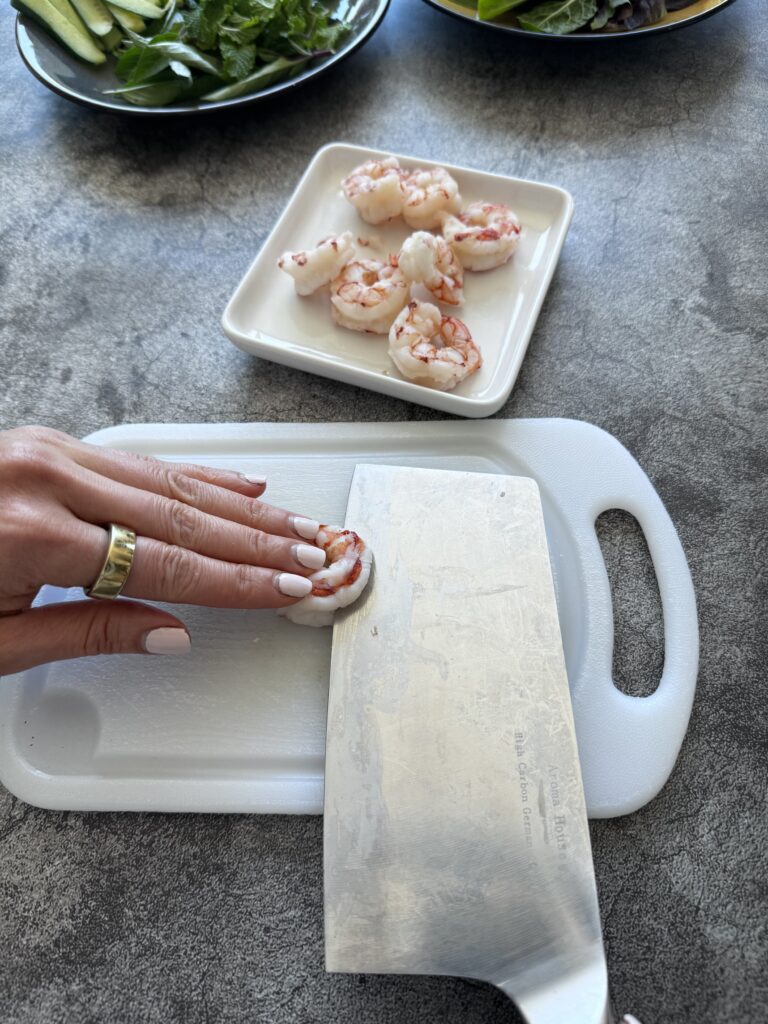
Cook Rice Noodles and Prepare the Vegetables
Step 1:
Cook the rice noodles according to package instructions. Drain and rinse under cold running water.
Step 2:
Wash the vegetables and dry them completely. Set aside on a plate.
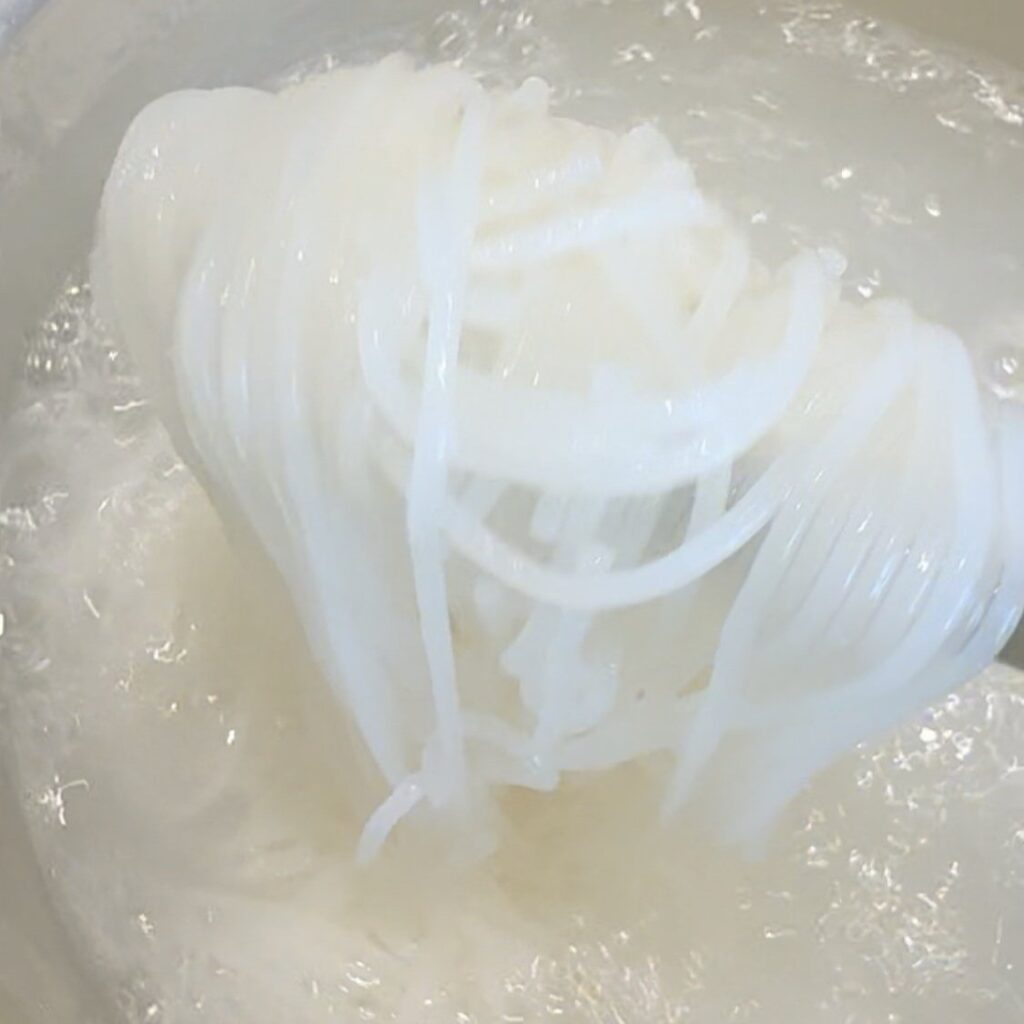
Roll the Spring Rolls
Step 1:
Set up a Spring Roll Station by adding warm water to a large, deep bowl. Lay out all your veggies, herbs, and shrimp on a plate. Have rice paper nearby in reach. Have a large chopping board and wet the surface so it is slightly damp.
Step 2:
Dip the rice paper in the warm water to moisten the entire surface, rotating if necessary. This should take just a few seconds.
Step 3:
Place the wet rice paper on the board. Place a piece of lettuce close to the bottom edge of the rice paper. Arrange a small piece of rice noodles (about 2-3 tablespoons), then herbs and cucumbers over the lettuce.

Step 4:
Arrange 3 pieces of shrimp, orange/pink side facing down, about 1.5 to 2 inches below the top edge of the rice paper.
Step 5:
From the bottom up, roll the lower edge of the rice paper, lift, and roll up the spring roll. When you get to the shrimp, fold the right and left sides in, then continue to roll up until the end.
Step 6:
Repeat the process with the remaining ingredients. If the chopping board dries out, dampen it again with water. Serve with peanut dipping sauce.
How to roll a spring roll
For the Peanut Sauce
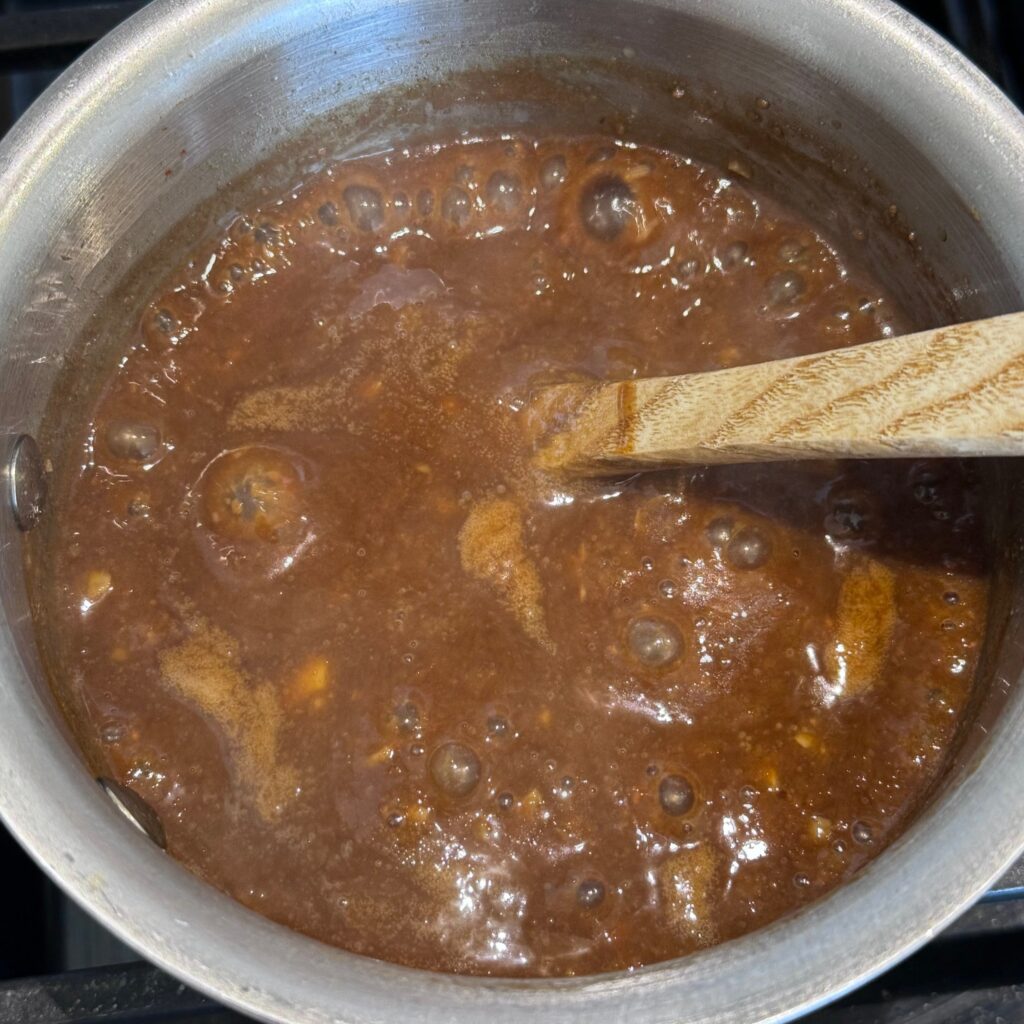
Step 1:
In a pan over medium heat, add oil and sauté the garlic until fragrant. Add shallots and continue to fry for a minute.
Steps 2:
Add water, hoisin sauce, peanut butter, vinegar, and sugar and mix well. Lower the heat and simmer for 2 minutes. Remove from heat. The sauce will thicken as it cools. Sprinkle crushed peanuts on top.
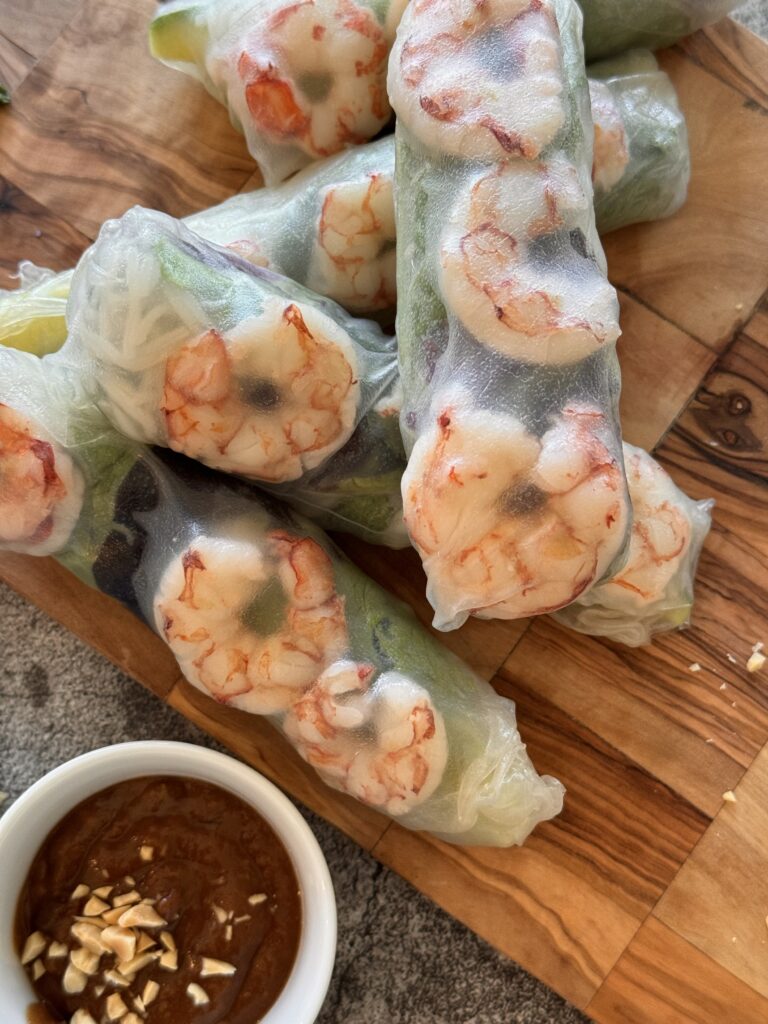
✅ Quick Tips: Read the recipe in its entirety before you start cooking. This will help you understand the ingredients, steps, and timing involved, and allow you to prepare any necessary equipment or ingredients beforehand.
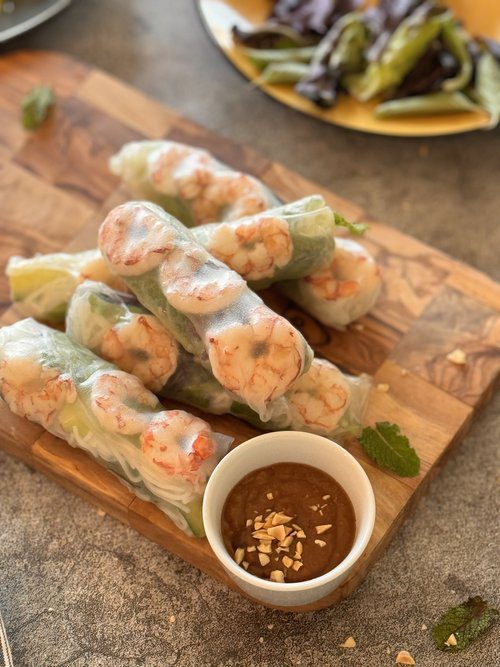
Vietnamese Shrimp Spring Rolls
Ingredients
For the Spring Rolls
For the Peanut Sauce
Nutritional Value
Nutritional Value
Servings 4
- Amount Per Serving
- Calories 486kcal
- % Daily Value *
- Total Fat 11g17%
- Saturated Fat 2g10%
- Trans Fat 0.01g
- Cholesterol 79mg27%
- Sodium 1325mg56%
- Potassium 652mg19%
- Total Carbohydrate 77g26%
- Dietary Fiber 5g20%
- Sugars 15g
- Protein 21g42%
- Calcium 133 mg
- Iron 4 mg
* Percent Daily Values are based on a 2,000 calorie diet. Your daily value may be higher or lower depending on your calorie needs.
